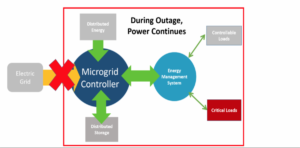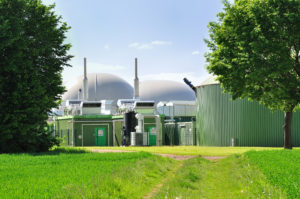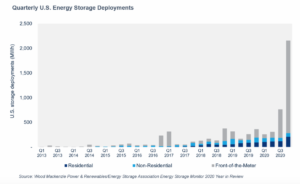March 18, 2021 – Volume 23, Issue 3
In This Issue
-
Flanigan’s Eco-Logic: Saluting the Aspen Skiing Company for Climate Action
- Microgrids 1.4: The Santa Rita Union School District Story
- Carbon Negative News
- All-Electric Tankers
- Hydrogen Updates: Saudi Arabia and Hydrogen Goop
- Energy Storage Updates
- The NetPositive Podcast with Andrew Waddell on Hillside Solar

Flanigan’s Eco-Logic: Saluting the Aspen Skiing Company for Climate Action
In this issue, we salute the Aspen Skiing Company, locally known in Colorado’s Roaring Fork Valley, as “Ski Co.” Some years ago, it developed a novel approach to generate power while demonstrating a cost-effective fix to a local problem with global impacts. The project involved capturing methane emissions from an abandoned mine in the town of Somerset – miles from Aspen’s slopes and in neighboring Gunnison County. Once captured, the methane has been and continues to be combusted to generate electricity. The Ski Co did two things at once: It made a sound investment while taking highly progressive climate action.
This was the brainchild of my colleague and friend, the late Randy Udall. We worked together at Rocky Mountain Institute, after which he ran CORE, the Community Office for Resource Efficiency, a non-profit dedicated to saving energy and cutting carbon. He realized the potency of methane… what he called “carbon on steroids.” Molecule-for-molecule and over 20 years, methane has 80 times the greenhouse gas intensity of carbon dioxide. It’s potent stuff. Randy viewed it as a local resource. It’s a fuel. By capturing the methane and safely converting it through combustion, its GHG potency is dramatically downgraded.
Auden Schendler, a former employee of mine, and now Vice President of Environmental Sustainability at Ski Co, explains that it had been focused on energy for years to drive down its carbon footprint. It had done small and pioneering solar and hydro projects… but it wanted to generate significant power to offset its load.
Udall and Schendler approached the Elk Creek Mine in Somerset owned by Bill Koch. Initially, they got the cold shoulder: The mine was pulling a million dollars of coal out of the ground each day and thus a million-dollar-a-year methane capture plant was not of particular interest. Udall and Schendler, however, were persistent and ultimately the mine did allow the novel project.
Ski Co made a $5.3 million investment in the methane capture plant that opened in 2012. The plant generates 3 MW of baseload power, while preventing emissions of 250 billion cubic feet of methane annually into the atmosphere. Ski Co sells the plant’s output directly to Holy Cross Energy, earning generation and carbon credit values. A fire in the mine caused a setback, but didn’t kill the project. In fact, the fire resulted in closure of the mine in 2014. The mine, however, will emit methane for the next 20 – 30 years. Ski Co’s methane capture plant remains fully operational. It will be fully paid off this year after reaping an 8% annual return.
Another former RMI colleague, Rick Heede, now runs the Carbon Accountability Institute. Heede too salutes Ski Co and reports that there are 48,528 abandoned mines in the country, many still dumping methane into the air. So will Ski Co do it again? Schendler explains the efforts that he and his colleagues went through to replicate the project… all to no avail. High risks, small returns, so probably not. He travelled to several states looking for projects without success. While mine methane capture is standard practice in Europe, it has yet to catch on in America.
Ski Co deserves great credit for giving it a go, being an innovator extraordinaire. Through methane capture – collecting a dangerous, atmospheric pollutant – it is generating enough power for its entire four-mountain operation. Now Schendler is focused on the next model project, a net-zero hotel in Mammoth, California using that region’s rich geothermal energy for heating.
Check out The NetPositive Podcast with Ted Flanigan featuring Auden Schendler. A terrific storyteller, Auden describes Ski Co’s energy and methane capture works… the genesis, challenges, environmental benefits, economics, and leadership:
Quote of the Week

Photo credit: Karl Wolfgang
“I don’t believe that methane is a pollutant.I think that coal has been good for society…”
Jim Cooper, Mine Manager, Elk Creek Mine, Somerset, CO
So why partner with the Aspen Skiing Company?
“Because I am resource guy,and I don’t want to see this resource wasted.”
Microgrids 1.4: The Santa Rita Union School District Story
 This story is about EcoMotion’s own first adventures with microgrids. We were hired by the Santa Rita Union School District in October 2015. It’s an elementary and middle school district in Monterey County, California… specifically in Salinas, the home of Steinbeck.
This story is about EcoMotion’s own first adventures with microgrids. We were hired by the Santa Rita Union School District in October 2015. It’s an elementary and middle school district in Monterey County, California… specifically in Salinas, the home of Steinbeck.
A District official there had heard about Tesla’s “Giga-factory” and wanted to bring batteries to her campuses to keep kids in school to learn despite power outages. Batteries, however, are expensive and the District wanted 7.5-hour duration… enough for campuses to ride through the entire school day. Three years later, I’m happy to report that all six campuses got the batteries, and as a bonus, the campuses are now also 100% solar-powered.
I credit my colleague Michael Ware. He recognized that if the campuses had solar, they would qualify for a Pacific Gas and Electric (PG&E) rate change. The solar would not only provide green kilowatt-hours at a discount, but the rate change would eliminate utility demand charges. In combination, the savings were significant and big enough to pay for the costly batteries.
At the end of the day, the microgrid systems – made up of solar arrays, batteries, and controls – were fully financed. The cost is virtually the same as the District used to pay to PG&E for grid power. That’s what we call parity… the same price. As PG&E rates escalate, the microgrids will be providing small savings to the District each year.
We began by analyzing the electric loads for each campus. Loads vary by season at schools. We determined an “average load,” and then with our colleagues at Avalon Batteries, we ran probabilities of the percentage of the time that the school would have ample power based on average conditions. If we could “hit” an 80% or 90% coverage in any given month… that was sufficient. Our job was to serve critical loads with costly batteries. Too many batteries would have meant higher costs, and thus a higher PPA rate, and we wouldn’t have achieved parity. To make the systems economic we had to thread the needle between resilience and cost-effectiveness.
Imagine this perfect storm scenario: It’s 8:15 and all teachers and students have arrived at school. It’s raining and dark, thus zero solar production. The batteries are full… but that’s it! Then a tree knocks out one of PG&E’s power lines and our microgrids must power the schools all on their own. The schools go into “battery mode.” Using the wireless control systems for all HVAC that we helped install, the District cuts the HVAC except minimal ventilation. Staff has been trained for battery mode, and all appliances are turned off. All critical systems – refrigerators, communications, lighting – remain running operable for the duration of the school day—7.5 hours! The students and teachers are safe and learning, all while the storm rages outside.
Points of interest along the way: SolEd Benefit Corporation is to be credited for developing the systems with us. SolEd shared our vision of using the solar in combination with batteries to provide daily resilience. Many financiers shied away from the project given the novel PPA proposed that mixed revenue generating (solar) and non-revenue generating assets (batteries). Finally, Generate Capital, led by Jigar Shah, got the vision and bought the systems.
Getting interconnected with PG&E was a long process. Even more trying were technical glitches between the inverters and the control systems that prevented the “battery mode” from working as planned. The solar is big and visible and has been providing savings as planned, but for two years the batteries have not been properly controlled. Fortunately, and just this month, new controls will be installed and the system should be fully operational this spring.
At the end of the day, the SRUSD story tells many lessons. Perhaps the biggest lesson is that you can pair solar and storage and controls, finance the package, and reap multiple economic, environmental, and societal benefits. At SRUSD, a model was crafted that provides carbon-free power each and every day. When SRUSD’s microgrids are fully buy clonazepam fast delivery tuned in, they’ll be able to operate indefinitely when islanded from the grid.
Carbon Negative News

Net Negative Bioenergy Works: Schlumberger New Energy, Chevron Corporation, Microsoft, and Clean Energy Systems have recently announced plans to develop a bioenergy plant with carbon capture and sequestration (BECC) designed to produce carbon negative power. It will be located in Mendota, California.
The plant will convert agricultural waste biomass, such as spent almond trees, into a renewable synthetic gas. The gas will then be mixed with oxygen in a combustor to generate electricity. More than 99% of the carbon from the BECC process is expected to be captured for permanent storage by injecting CO2 underground into nearby deep geologic formations.
For those of us that periodically drive the Interstate 5 corridor in California’s Central Valley and wondered, here’s a little info on almond trees. Apparently they only productive for 20 – 25 years. After that, they are cleared, put in the huge piles that we see off the freeway, then burned on the spot or chipped, and finally taken to a cogeneration plant. They are then replaced with saplings that start producing almonds in about three years. Pistachios produce for 70 years; citrus can give fruit for 100 years.
By using biomass fuel that consumes CO2 over its lifetime, and then permanently storing the CO2 after the fuel’s use, the result is net negative carbon emissions. When completed, the plant is expected to remove 300,000 tons of CO2 annually. It will consume ~200,000 tons of agricultural waste each year in the Central Valley, aligned with a recent California Air Resources Board plan to phase-out most agricultural burning by 2025.
Electric Scooters: In related net negative news, Electrek reports that the electric scooter company, Ola Electric, is building a massive “FutureFactory” that will produce one of its EVs every two seconds… and that the factory will be net negative in terms of emissions. It is currently under construction in the southern Indian state of Tamil Nadu. The scooter’s top speed is 62 mph; it has a range of 62 miles.
The FutureFactory is built on a 500-acre site, and thanks to 3,000 AI-enabled robots, will be producing 2 million scooters a year in 2022, and then 10 million per year in 2023 at full capacity. The factory will have its own emissions-free indoor track so that the company can do testing in inclement weather. There is a two-acre forest within the complex that is surrounded by 100 acres of forest. The roof will house a vast solar array… allowing the factory to be carbon negative. Ola is calling its factory the most sustainable in the world.
All-Electric Tankers
 Oil tankers and cargo ships are some of the biggest and most polluting vehicles on the planet. The heavy fuel oil that they burn has a high sulfur content. Now a consortium of Japanese companies has teamed up to develop the world’s first all-electric tankers.
Oil tankers and cargo ships are some of the biggest and most polluting vehicles on the planet. The heavy fuel oil that they burn has a high sulfur content. Now a consortium of Japanese companies has teamed up to develop the world’s first all-electric tankers.
Editorial: Really? Seems like a perverse twist with electric battery-powered propulsion transporting its slick nemesis and the combustion that it fuels.
One of the consortium companies, Asahi Tanker, has ordered two of the first vessels to be built for operations in 2022 and 2023. Each of the 200-foot ships will have a 3.5 MWh battery pack. A secondary use for the tankers’ battery packs is for emergency services in the case of a natural disaster in Tokyo.
Hydrogen Updates: Saudi Arabia and Hydrogen Goop
Saudi Arabia: Bloomberg news reports that Saudi Arabia has a bold plan, “To rule the $700 billion hydrogen market.” It wants to be the world’s largest supplier of hydrogen. The kingdom is building a $5 billion plant to make green fuel for export and lessen the country’s dependence on “petro-dollars.”
Sun-scorched expanses and steady Red Sea breezes make the northwest tip of Saudi Arabia prime real estate for a global hub for green hydrogen, with the potential to turn “a patch of desert the size of Belgium” into a renewable energy powerhouse. The Helios Green Fuels plant there will be entirely powered by the sun and wind and will be among the world’s largest hydrogen makers. It is being built in Neom and is slated to be online by 2025.
Hydrogen is difficult to store and is highly combustible. Furthermore, green hydrogen is expensive, ~$5/kilogram. Helios may be able to address this cost. Saudi Arabia provides the competitive advantages of perpetual sun and wind, and huge tracts of land. Helio’s cost could reach as low as $1.50/kg by 2030. That’s cheaper than hydrogen made with fossil fuels today. Helios will use 4 GW of solar and wind to produce 15,000 barrels of oil equivalent per day.
 Hydrogen Goop: The Economist reports that the “hydrogen goop” being developed at the Fraunhofer Institute in Germany could be a more convenient fuel than hydrogen gas. Why? Hydrogen goop crams more energy into space than hydrogen gas does.
Hydrogen Goop: The Economist reports that the “hydrogen goop” being developed at the Fraunhofer Institute in Germany could be a more convenient fuel than hydrogen gas. Why? Hydrogen goop crams more energy into space than hydrogen gas does.
They call it Powerpaste. It addresses hydrogen storage in a novel way: Conventional means include compressing hydrogen gas several hundred-fold. Typically, hydrogen is used in cars in a gaseous form, pressurized to 10,150 PSI. That requires tanks that are heavy and large, counteracting the key advantage of hydrogen’s power density compared to batteries. Liquefying hydrogen is another option, but requires temperatures of -253c. Thus “rugged tanks” with special metals are needed since conventional tanks suffer from hydrogen gas infiltration in metals, weakening them, and in cases causing cracks.
The makers of Powerpaste hail from the Fraunhofer’s Manufacturing Technology and Advanced Materials section in Desden, Germany. Researchers there came up with this sludgy gray paste. To develop it, they heat hydrogen with magnesium and stabilizers. The end result is that the hydrogen can be stored at room temperature in cartridges. It’s a stable medium that is 10 times more energy dense than lithium-ion batteries. Think of the potential for EV range; think of the plug and play refueling in mere seconds. A Powerpaste power train may feature a range comparable or even greater than gasoline.
Digging a bit deeper, the paste is made by combining hydrogen and magnesium into magnesium hydride, then adding an organic compound called an ester, as well as metal salt. These last two are conditioners, helping to turn the magnesium hydride into a stable, uniform paste. When it comes time to release the energy, a plunger mechanism extrudes the paste into a chamber where it reacts with water to release hydrogen at a dynamically controlled rate. The hydrogen gas is then fed into a fuel cell to create electrical power with which to run an electric vehicle.
Refueling a scooter would be a matter of pulling out a cartridge and replacing it with a full one at a service station. The Fraunhofer team envisions these cartridges powering drones too. Powerpaste can also be trucked in barrels or tankers.
Energy Storage News
 Record Volumes: Wood Mackenzie reports that the last quarter of 2020 was big for storage in America, again for the fourth quarter in a row. The U.S. Energy Storage Association reports that 651 MW/2,156 MWh of new storage was brought online. That tops the 2,000 MWh waterline for the first time in a single quarter. That’s up 182% from Q3 2020… and way above the ~20 MWh in each quarter of 2013! The United States installed more battery capacity in 2020 than it did from 2013 – 2019.
Record Volumes: Wood Mackenzie reports that the last quarter of 2020 was big for storage in America, again for the fourth quarter in a row. The U.S. Energy Storage Association reports that 651 MW/2,156 MWh of new storage was brought online. That tops the 2,000 MWh waterline for the first time in a single quarter. That’s up 182% from Q3 2020… and way above the ~20 MWh in each quarter of 2013! The United States installed more battery capacity in 2020 than it did from 2013 – 2019.
Front-of-the-meter storage is taking off. That’s on the utility’s side of the meter, supporting grid operations. Four of every five megawatts deployed in Q4 was for grid support, 529 MW of the total 651 MW.
Tax Credit Proposed: On March 9, 2021 a bill was introduced in the U.S. House of Representatives called the Energy Storage Tax Incentive and Deployment Act. The bipartisan legislation would create a stand-alone investment tax credit for energy storage technologies for utilities, businesses, and homes.
The bill includes a wide range of storage systems including pumped hydropower, hydrogen storage, thermal energy storage, regenerative fuel cells, and superconducting magnets. The current tax code allows an investment tax credit for energy storage only when it is installed in conjunction with a solar energy system. This new bill would extend the tax credit to a wider range of applications.
Residential Vanadium Flow: Residential vanadium flow batteries are now making waves. Flow batteries have some clear advantages over lithium-ion. They are non-flammable. They are not volatile. They do not need to be replaced after 10 years. EcoMotion has been tracking Avalon Batteries – now Invinity – for years. It makes commercial-sized flow battery units. Matt Harper, Invinity’s Chief Technical Officer, welcomes the new market entrants in the residential sector, cautioning care in deployment of this chemistry to optimize its benefits.
The NetPositive Podcast: Andrew Waddell on Hillside Solar
 This edition of EcoNet News, Volume 23, Issue #3 is also available in podcast format. Check out The NetPositive with Ted Flanigan on Spotify, Apple, and Google. Episodes includes Convos (Conservations), the News (EcoNet News), and Uni (the EcoMotion University).
This edition of EcoNet News, Volume 23, Issue #3 is also available in podcast format. Check out The NetPositive with Ted Flanigan on Spotify, Apple, and Google. Episodes includes Convos (Conservations), the News (EcoNet News), and Uni (the EcoMotion University).
Hillside Solar is in focus in a current episode that features a conversation with Andrew Waddell, EcoMotion’s brand new Solar Project Manager. He and Ted discuss research highlights and LA-area projects, weaving together the inherent challenges yet quite attractive opportunities for Hillside Solar.
